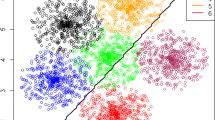Abstract
This paper presents several criteria for partition of classes for the support vector machine based hierarchical classification. Our clustering algorithm combines support vector machine and binary tree, it is a divisive (top-down) approach in which a set of classes is automatically separated into two smaller groups at each node of the hierarchy, it splits the classes based on the normalized cuts clustering algorithm. Our clustering algorithm considers the involved classes rather than the individual data samples. In the new proposed measures, similarity between classes is determined based on boundary complexity. In these measures, concepts such as the upper bound of error and Kolmogorov complexity are used. We reported results on several data sets and five distance/similarity measures. Experimental results demonstrate the superiority of the proposed measures compared to other measures; even when applied to nonlinearly separable data, the new criteria perform well.



Similar content being viewed by others
References
Breiman L, Friedman J, Olshen RA, Stone CJ (1984) Classification and regression trees. Chapman and Hall, London
Fei B, Liu J (2006) Binary tree of SVM: a new fast multiclass training and classification algorithm. IEEE Trans Neural Netw 17(3):696–704
Bishop CM (1995) Neural networks for pattern recognition. Oxford University Press, Oxford
Knerr S (1990) Single-Layer learning revissted: a stepwise procedure for building and training a neural network, Neurocomputing: Algorithms, Architectures and applications. NATO ASI series, vol F68, Springer, pp 41–50
Bay SD (1998) Combining nearest neighbor classifiers through multiple feature subsets. In: Proceedings of the 17th international conference on machine learning. Madison, WI, pp 37–45
Irina Rish (2001) An empirical study of the naive Bayes classifier. In: IJCAI workshop on empirical methods in artificial intelligence
Changa C–C, Chien L-J, Lee Y-J (2011) A novel framework for multi-class classification via ternary smooth support vector machine. Pattern Recognit 44(6):1235–1244
Allwein E, Schapire R, Singer Y, Kaelbling P (2000) Reducing multiclass to binary: a unifying approach for margin classifiers. J Mach Learn Res 1:113–141
Duan KB and Keerthi SS (2005) Which is the best multiclass svm method? An empirical study. In: Proceedings of the sixth international workshop on multiple classifier systems, pp 278–285
Garcıa S, Herrera F (2008) An extension on “statistical comparisons of classifiers over multiple data sets” for all pairwise comparisons. J Mach Learn Res 9:2677–2694
Hsu C-W, Lin C-J (2002) A comparison of methods for multiclass support vector machines. IEEE Trans Neural Netw 13(2):415–425
Rifkin R, Klautau A (2004) In defense of one-vs-all classification. J Mach Learn Res 5:101–141
Galar M, Fenandez A, Barrenechea E (2011) An overview of ensemble methods for binary classifiers in multi-class problems: experimental study on one-vs-one and one-vs-all schemes. Pattern Recognit 44:1761–1776
Samuel R.R (2010) Model combination in multiclass classification, PhD thesis, University of Colorado
Hastie T, Tibshirani R, Friedman J (2003) The elements of statistical learning. Springer, Berlin
Lorena vA (2008) Review on the combination of binary classifiers in multiclass problems. Artif Intell Rev 30(1–4):19–37
Dietterich TG, Bakiri G (1995) Solving multiclass learning problems via error-correcting output codes. J Artif Intell Res 2:263–286
Ou G, Murphy YL (2007) Multi-class pattern classification using neural networks. Pattern Recognit 40(1):4–18
Vural V and Dy JG (2004) A hierarchical method for multi-class support vector machines. In: Proceedings of the twenty-first international conference machine learning
Casasent D, Wang Y-C (2005) A hierarchical classifier using new support vector machines for automatic target recognition. Neural Netw 18:541–548
Chen Y, Crawford MM, Ghosh J (2004) Integrating support vector machines in a hierarchical output space decomposition framework. In: Proceedings of the international geoscience remote sensing Symposium, pp 949–952
Griffin G, Perona P (2008) Learning and using taxonomies for fast visual categorization. IEEE computational society conference on computer vision and pattern recognition
Zhigang L, Wenzhong S, Qianqing Q, Xiaowen L, Donghu X (2005) Hierarchical support vector machines. Geosci. Remote Sensing Symp
Yan D, Huang D, Jordan MI (2009) Fast approximate spectral clustering. In: Proc. ACM Int. Conf. Knowl. Disc. Data Mining, Paris, France
Lu JF, Tang JB, Tang ZM, Yang JY (2008) Hierarchical initialization approach for k-means clustering. Pattern Recognit Lett 29:787–795
Loewenstein Y, Portugaly E, Fromer M, Linial M (2008) Efficient algorithms for accurate hierarchical clustering of huge datasets: tackling the entire protein space. Bioinformatics 24(13):i41–i49
Hamidzadeh J, Monsefi R, Sadoghi Yazdi H (2012) DDC: distance-based decision classifier. Neural Comput Appl 21:1697–1707
Vural V and Dy JG (2004) A hierarchical method for multi-class support vector machines. In: Proceedings of the twenty-first international conference on machine learning
Chen Y, Crawford M.M, Ghosh J (2004) Integrating support vector machines in a hierarchical output space decomposition framework. In: Proceedings of the International on Geoscience and Remote Sensing Symposium, pp 949–952
Griffin G, Perona P (2008) Learning and using taxonomies for fast visual categorization. IEEE Comput. Soc. Conf. on Computer Vision and Pattern Recognition
Cevikalp H (2010) New clustering algorithms for the support vector machine based hierarchical classification. Pattern Recognit Lett 31(11):1285–1291
Cortes C and Vapnik V (2002) Support-vector networks. Mach Learn 273–297
Basu M, Ho TK (2006) Data complexity in pattern recognition. Springer, Berlin
Li L (2006) Data complexity in machine learning and novel classification algorithms, PhD thesis, California Institute of Technology
Furnkranz J (2006) Round robin classification. J Mach Learn Res 2:721–747
Pelckmans K, Suykens J.A.K, Van Gestel T, De Brabanter J (2003) Ls-SVM: alibrary for support vector machines http://www.esat.kuleuven.ac.be/sista/lssvmlab/
Michie D, Spiegelhalter D. J and Taylor C. C (1994) Machine Learning, Neural and Statistical Classification [Online]. Available:ftp.ncc.up.pt/pub/statlog/
Asuncion A, Newman D, UCImachinelearningrepository (2007) URL:http://www.ics.uci.edu/_mlearn/MLRepository.html
Hullermeier E, Vanderlooy S (2010) Combing predictions in pairwise classification: an optimal adaptive voting strategy and its relation to weighted voting. Pattern Recognit 43:128–142
Author information
Authors and Affiliations
Corresponding author
Rights and permissions
About this article
Cite this article
Ghaffari, H.R., Sadoghi Yazdi, H. Multiclass classifier based on boundary complexity. Neural Comput & Applic 24, 985–993 (2014). https://doi.org/10.1007/s00521-012-1303-9
Received:
Accepted:
Published:
Issue Date:
DOI: https://doi.org/10.1007/s00521-012-1303-9




